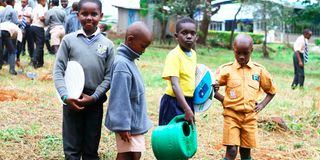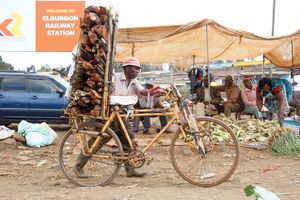Meet children on the frontline of climate crisis

St Mary’s School Environment club members during the interview on July 24.
What you need to know:
- Junior, the head boy in the junior section of St. Mary's School, creates awareness by talking to his friends and family about ways to conserve the environment.
- Using his passion for public speaking, he says he has convinced about 30 percent of the people he interacts with to stop littering.
If he met an influential leader today, Junior Ambani Osogo would ask them to educate, engage, and involve children in climate action. The 12-year-old learner also wishes policymakers and leaders would push for more climate change awareness. Junior, a learner at St. Mary's School in Nairobi, feels everyone would be more proactive if they were constantly reminded of the hostilities that are coming if the climate crisis is not addressed.
He's not alone in this. Tyler Akidiva, 11, wishes he could manufacture affordable climate clocks to give to everyone. He says that seeing them tick always reminds him that time is running out. Both learners are part of the Environmental Club at St. Mary's School. They are part of a larger group of pupils who meet every Monday afternoon to deliberate on ways to survive climate change and actively bring more people on board.
Junior, the head boy in the junior section of the school, creates awareness by talking to his friends and family about ways to conserve the environment. Using his passion for public speaking, he says he has convinced about 30 percent of the people he interacts with to stop littering. He plans to inspire those around him to start planting sentimental trees on their birthdays instead of holding the usual cake parties. For him, participating in the environmental club opened his eyes to the devastating impacts of climate change.
Tyler's mother, Irene Ogaju, says she has seen a huge improvement in his appreciation and interaction with nature and a growing passion for climate action. Tyler, who also serves as the club's president, was already a nature lover before he joined. Now his mum says he's more engaged in conservation and has taken to planting trees whenever possible.
He is more intentional when communicating with others, always emphasising the importance of planting trees and adopting more sustainable practices. Tyler dreams of joining The United Nations Environment Programme (UNEP) one day and use it to advocate for children's inclusion in sustainable development. Part of the learners' active roles is planting specific trees in their school compound and community. They have also learnt meaningful waste segregation and now use their school's single-use plastic cups to plant seedlings. Further, they teach those around them what they learn at school in the hopes of a collective reaction.
Their teacher, Kasisi Wafula, is positive that involving children in climate action is an added advantage towards attaining Sustainable Development Goals (SDGs). He believes the urgency with which the 2030 global goal deadline approaches requires all hands on deck, and children have much more to offer if given the opportunity.
“A tree planted by an adult is the same as a tree planted by a child, but with better survival chances as children show more dedication in nurturing,” he quips.
As the club's patron, Kasisi walks the learners through the SDGs, which he’s happy to note are well incorporated into the current syllabus, the Competency Based Curriculum . To him, involving the learners in sustainable practices goes beyond planting trees. He sees the potential for career paths in adaptive measures as well.
In support of SDG education, the school has taken measures to teach learners the importance of conserving the environment. Other than tree planting, members of the club have undergone various trainings. The most recent was a drone assembling activity, a partnership with Kenya Flying Labs, where 19 participants learnt to assemble and fly drones. These, they were taught, can be used in many conservation activities. Besides tasks like waste collection in oceans and eco-friendly delivery services, the learners found out they could use these drones to map out forest areas where they can add forest cover without necessarily walking there. The drones can be adjusted to drop an intentional number of seed balls in a given area, accomplishing what would require many people to complete, and in a short time. This, Kasisi explains, has revealed many career choices to his learners. “Now, some want to pursue Aeronautical Engineering while others are keen to try out Robotics.”
The school is particular about the trees they encourage their learners to plant. Kasisi says planting trees for timber encourages harvesting in the next decade or so. Their approach is different; planting trees for nourishment, where people will let the tree be even after maturity. The school advocates for orchards that will grow to provide fruits and nuts like macadamia and pawpaws. In a joint initiative with Climate Clock, an organisation that advocates for quick climate action, the school recently planted 38 fruit trees. This was in celebration of a partner who was marking her 38th birthday.
St. Mary's School's reaction to climate change highlights how much children can help attain the SDGs and others targeted at cooling the planet. As a patron, Kasisi has observed that children listen a lot more to their teachers compared to their parents, especially on educational matters. Therefore, he notes teaching them the effects of climate change and how to mitigate and adapt to it at school has a huge impact. He says adding them to the equation helps achieve the SDGs faster and helps children deal better with climate change, a crisis they were born into.

St Mary’s School Environment club members water plants at their farm in the institution on July 24.
His sentiments echo those of the United Nations Children's Fund to protect, prepare and prioritise every child in climate matters. In its 2022 report, A Call To Action On Climate And Children, the organisation noted that children are one of the largest groups at risk from climate change, with over one billion children at extremely high risk.
It called for adopting child-led measures to reduce the impacts of climate change across a large proportion of the population. The report estimated that protecting every child by adopting child-oriented services, preparing every child by building their adaptive capacity and prioritising children in climate funding and resources will reduce the number of people in need of international humanitarian assistance due to climate-related disasters by 10 million by 2050.
Save The Children also warns that every child will inherit a planet with more frequent extreme weather events than ever before. Twenty four million children are projected to be undernourished due to the climate crisis by 2050 and the organisation is pushing to sustain and scale up child-centered anticipatory action systems globally.
At COP27 in Egypt last year, there was a children’s pavilion, the first time in the history of the COP that children were involved in the climate talks. In the pavilion, there were children of all ages participating in various activities, including inviting and asking policymakers questions. It is hoped that this year’s COP will also put children at the centre.





